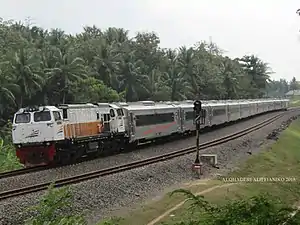Rail transport in Indonesia
The majority of Indonesia's railways are on Java, used for both passenger and freight transport. There are three noncontinuous railway networks in Sumatra (Aceh and North Sumatra; West Sumatra; South Sumatra and Lampung) while two new networks are being developed in Kalimantan and Sulawesi.[7][8] Indonesia has finalized its plan for a national railway network recently. According to the plan, 3,200 km of train tracks that will criss-cross the islands of Sumatra, Java, Kalimantan, and Sulawesi, it has been touted as the most extensive railway project in Indonesia since its independence from the Dutch in 1945.[9] Indonesia targets to extend the national railway network to 10,524 kilometres by 2030. As of September 2022, the network spans 7,032 km.[10]
| Indonesia | |
|---|---|
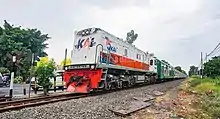 Sri Tanjung train in Surabaya. | |
| Operation | |
| National railway | |
| Statistics | |
| Ridership | 429.2 million (2019)[1] |
| Freight | 995.5 million tonnes (2015, as of October)[2] |
| System length | |
| Total | 6,600 kilometres (4,100 mi) [3] |
| Electrified | 478 kilometres (297 mi) |
| Track gauge | |
| Main | 1,067 mm (3 ft 6 in) |
| Standard gauge 1,435 mm (4 ft 8+1⁄2 in) | 107.7 kilometres (66.9 mi) |
| Electrification | |
| Main | 1.5 kV DC overhead line |
| Features | |
| Longest tunnel | Sasaksaat Tunnel 949 m (3,114 ft)[4] |
| Longest bridge | Cikubang Bridge 300 m (980 ft)[5] |
| Highest elevation | 848 m (2,782 ft) |
| at | Nagreg railway station[6] |
| Lowest elevation | 1 m (3 ft 3 in) |
| at | Surabaya Pasar Turi railway station[6] |
Urban railway exist in form of commuter rail in all provinces and metropolitan areas of Java – notably in Jakarta – as well as Medan, North Sumatra. New mass rapid transit and light rail transit system are currently being introduced in Jakarta and Palembang, South Sumatra.
Despite Indonesia having a left-hand running for roads, most of the railway lines use right-hand running due to Dutch legacy.
Indonesia's rail gauge is 1,067 mm (3 ft 6 in), although 1,435 mm (4 ft 8+1⁄2 in) and 750 mm (2 ft 5+1⁄2 in) lines previously existed. Newer constructions in Sumatra including Aceh, Kalimantan, Sulawesi, and Papua, along with the Jakarta LRT and Jakarta-Bandung HSR, are using the 1,435 mm gauge. Most of the Jakarta metropolitan area is electrified at 1500 V DC overhead.
Indonesia's railways are primarily operated by the state-owned Kereta Api Indonesia (KAI), its commuter subsidiary KAI Commuter, and the airport rail link subsidiary KAI Bandara. The infrastructure is state-owned, and companies pay a fee for using the railways.
Various narrow gauge industrial tramways operate in Java and Sumatra, serving the sugarcane and oil palm industries.
History
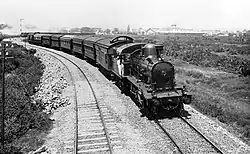
The first railway line in Indonesia opened in 1867 and was initially laid to standard gauge size. The railways were gradually expanded by both the state and private companies.
The Japanese occupation and the Indonesian War of Independence left Indonesia's railways in a poor condition. A batch of 100 steam locomotives were ordered in 1950, and dieselisation started in 1953. By the 1980s most mainline services had been dieselised. Electric multiple units were obtained from Japan beginning in the 1970s, replacing 60-year-old electric locomotives.
Since the independence era, all mainline railways in Indonesia have been managed by the state. The owners of the private railway were compensated first, but the system was fully nationalised in 1971.
Construction of new railway lines has been scarce, and most new construction is concentrated on double- and quad-tracking of existing railway lines. Most of the former tramway lines have been closed, reducing the mileage from about 7000 km to only 3000 km.
Regulator and operators
Regulator
The sole regulator of Indonesian rail transport system is Directorate General of Railways, Ministry of Transportation. Established 5 August 2005 during the reign of Susilo Bambang Yudhoyono, the directorate general was designed to regulate rail transport policies in Indonesia.[11] The first Director-General was Soemino Eko Saputro, who had served as CEO of Perumka. When he was served as the Director-General, Saputro was involved in a corruption case concerning procurement of EMUs from Japan, which caused the state to lose IDR 20 billion.[12]
Operators
There are a bunch of passenger and freight rail companies in Indonesia:
- PT Kereta Api Indonesia (KAI) — operates local, regional, and intercity trains
- PT Railink (KAI Bandara) — operates airport rail link services, joint venture with Angkasa Pura II
- PT Kereta Commuter Indonesia (KAI Commuter) — operates commuter rail services
- PT Kereta Api Logistik (KAI Logistik) — operates courier-by-rail services
- PT MRT Jakarta — operates Jakarta MRT, province-owned company of Special Capital Region of Jakarta
- PT LRT Jakarta — operates Jakarta LRT, subsidiary of Jakpro, a province-owned company of Special Capital Region of Jakarta
- PT Angkasa Pura II — operates Soekarno-Hatta Airport Skytrain
- PT Kereta Cepat Indonesia–China — planned to operate Jakarta–Bandung high-speed rail, joint venture of PT Pilar Sinergi BUMN Indonesia and Beijing Yawan HSR Co. Ltd.
Some agricultural companies also operates industrial railways:
- Perkebunan Nusantara (state-owned)
- PT Perkebunan Nusantara II — operates palm oil trains
- PT Perkebunan Nusantara IV — operates palm oil trains
- PT Perkebunan Nusantara IX — operates sugarcane lines and tourist train
- PT Bakrie Sumatra Plantations (part of Bakrie Group) — operates rubber and palm oil freight trains
- PT Tanjung Enim Lestari — operates pulp freight trains
Rail infrastructures by region
Java

The first railways in Indonesia were built on the island of Java, using 1,435 mm (4 ft 8+1⁄2 in) gauge. During the Japanese occupation, they were converted to 1,067 mm (3 ft 6 in) gauge. At its greatest extent, the Javanese network had a length of 4,807 kilometres (2,987 mi), connecting most parts of the island.[13] The Javanese network train (in Java Island) is divided into nine operating divisions.
Sumatra
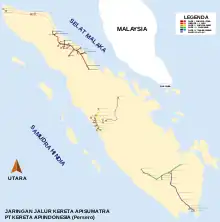
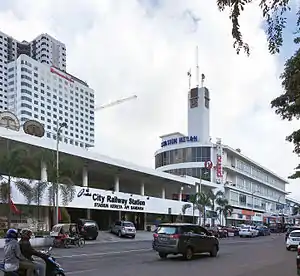
As of 2013, there are 1,869 kilometres of track in Sumatra, of which 1,348 km are operational.[14] Several unconnected railway networks were built in the time of the Dutch East Indies:
- Banda Aceh-Lhokseumawe-Besitang-Medan-Tebingtinggi-Pematang Siantar-Rantau Prapat in northern Sumatra (the Banda Aceh-Besitang section was closed in 1971, but is being rebuilt, as of 2011 [15]), using Track gauge 750 mm (2 ft 5+1⁄2 in).
- Padang-Solok-Bukittinggi in West Sumatra
- Bandar Lampung-Palembang-Lahat-Lubuk Linggau in southern Sumatra.
Plans to connect up and fix these isolated lines are included in the Trans-Sumatra Railway plan. Railway services in Sumatra by operational is divided into four regional divisions, which are:
| Regional Division 1 (North Sumatra and Aceh) |
Regional Division 2 (West Sumatra) |
Regional Division 3 (South Sumatra) |
Regional Division 4 (Lampung and South Sumatra) |
|---|---|---|---|
|
|
|
|
Kalimantan
The first railway network in Kalimantan island was opened in 1908, serving the oil refinery and port of Balikpapan. It was closed in 1950.[16] In 2010, plans were announced for Kalimantan to get a 122 km long 1,435 mm (4 ft 8+1⁄2 in) standard gauge railway for the transport of coal between the Muara Wahau mine and the port of Bengalon.[17] In January 2016, Russian Railways reported that the construction of a railway in Kalimantan will finish in 2019;[18] however, in 2022 they withdraw from the initial investment plan so the railway construction was canceled.[19]
Lesser Sunda Islands
In 2019, it was reported that governor of Bali Wayan Koster is planned to build railways on Bali with 1,435 mm (4 ft 8+1⁄2 in) standard gauge. The railway "is keen to improve Bali's transportation infrastructure and is considering plans to build an electric rail network across the island".[20]
Sulawesi

The first railway network in Sulawesi was opened in 1922 connecting Makassar and Takalar, but was closed in 1930 due to poor revenue.[21][22] The newer Trans-Sulawesi Railway is under construction as of 2022. It will be built with 1,435 mm (4 ft 8+1⁄2 in) standard gauge, which is wider than the cape gauge used in Java and most of Sumatra to accommodate more weight and speed.[23][24] The ground breaking of Makassar–Parepare route was conducted on 18 August 2014 in, Siawung Village, Barru District, Barru Regency. On early November 2022, 66 kilometres of railway from Barru to Pangkep was inaugurated and operational. As of 2022, it is the only operational part of the railway.[25][26]
Papua
A 440 km railway from Manokwari to Sorong in West Papua province is planned.[27] In Papua there is also a subway line assigned to transport mining products which is located in the Grasberg mine, Mimika Regency, near Puncak Jaya, and operated by PT. Freeport Indonesia and has been operating since 2019.[28] Besides that, a train line is also operated specifically for students at the Nemangkawi Mining Institute.[29]
Rolling stock
Preserved locomotives
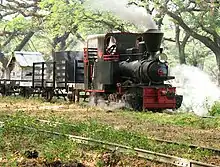
Indonesia had various types of locomotives, being the legacy of the many different companies. Surprisingly, only five steam locomotives remain in operable condition, with two located in the Ambarawa Railway Museum, two in Surakarta running the Jaladara excursion train, and one in the Sawahlunto Railway Museum. On the other hand, static steam locomotive displays are located in the Transportation Museum (under the auspices of the Department of Transportation) in Jakarta's Taman Mini Indonesia Indah (Beautiful Indonesia in Miniature Park) and Ambarawa Railway Museum (managed by PT Kereta Api) in Central Java. Plinthed locomotives can also be found in most cities and towns. Somewhat surprisingly, few non-locomotive rolling stock were preserved.
.jpg.webp)
With the Asian economic crisis of 1997, remaining hulks of steam locomotives formerly standing in former depots became valuable for their scrap value, and by 2000, most locomotives not already plinthed or sent to museums were scrapped, presumably illegally.
Four operable industrial steam locomotives are present, with two more preserved, at the Cepu Forest Railway. This currently represents the largest concentration of active preserved steam locomotives in Indonesia.
Several "last" steam locomotives were built for Indonesia. E10 60, a 1966-built rack steam locomotive (Esslingen 5316) is operable in Sawahlunto Railway Museum. BB84, the last Mallet locomotive built for a non-tourist railway (according to Durrant) was built by Nippon Sharyo Keizo Kaisha in 1962 (works number 2007). This locomotive was plinthed in Banda Aceh and survived the December 2004 tsunami. The locomotive is in rather poor condition with its valve gear and cylinder pistons missing (as of March 2006).
SS 1600-class steam locomotive No. 1622 "Sri Gunung" (Mountain Queen), a 1,067 mm (3 ft 6 in) mallet built in 1928, preserved in the Dutch Railway Museum.
The Trangkil No. 4 (Hunslet Engine Company 3902) was built in 1971, being the last steam locomotive built at Hunslet's Jack Lane Works in Leeds, England. The locomotive was used on the Trangkil sugar mill estate on Java. It has been repatriated to the UK in 2004.[30]
Sragi No.1 (Krauss) was built in 1899, restored to working order in 2008. This locomotive is a former sugar cane carrier in Pekalongan, Central Java. Then there are two other locomotives namely Pakis Baru No. 1 (Orenstein & Koppel built 1900) and Pakis Baru No. 5 (Orenstein & Koppel built 1905), both of which were former locomotives belonging to the Pakis Baru sugar factory in Pati, Central Java. All locomotives now preserved at Statfold Barn Railway, England.
Diesel locomotives
As of 2016, PT Kereta Api operates about 350 units of diesel locomotives divided into classes in Java and Sumatra[31] used both for passenger and freight services. The first diesel locomotive owned by PT Kereta Api was CC200 class, built by General Electric in 1953.[32]
Electric trains
As of August 2017, PT Kereta Api's commuter subsidiary, Kereta Commuter Indonesia, operates 758 units of electric multiple units (EMU) in Greater Jakarta area.[33] Most EMUs operated in Jakarta are secondhand trains acquired from major urban railway operators in Greater Tokyo in Japan, such as East Japan Railway Company and Tokyo Metro.
Usage
Passenger services
KAI provides extensive passenger services. Various classes are available, from luxury class with reclining seats and plane - like facilities, executive class with air conditioner and reclining seat comparable to the better classes of other countries' railways, business coaches which recently have been equipped with air conditioner and reclining seats much like executive class, to the hard bench, but still air conditioned, economy class coaches for cheaper trains. In last couple of years, the business and economic class are in the process of being equipped with air conditioned system. The whole process was completed in early 2013.
Sleeper trains have existed in Indonesia. The last all-sleeper train service was Bima express train which ran from 1967 to 1984 when it was changed to mostly coach, leaving only one or two sleeping cars. It ran in this configuration until 1995, when the sleeper cars were withdrawn and modified into seating coach. Since 2018, sleeper trains have been re-activated for the Argo Bromo Anggrek (Jakarta to Surabaya), Taksaka (Jakarta to Yogyakarta), Argo Lawu and Argo Dwipangga (Jakarta to Solo), and Gajayana (Jakarta to Malang).[34]
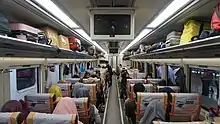
In Java, most trains connect Jakarta and the hinterland - regional (or "cross-country" services) have not been fully developed. Between pairs of important cities such as Jakarta and Bandung, intensive hourly services are provided.
Most passenger trains in Indonesia, except commuter locals, are named. The names varies from plainly descriptive such as Depok Ekspres (a former fast service between Jakarta and Depok), through Logawa (name of a river near Purwokerto, which is served by the train), Argo Lawu (Mt. Lawu, an extinct volcano near Solo, which is served by the said express train), to more or less meaningless, though romantic, names such as Bangunkarta (abbreviation of names of cities it serves: Jombang-Madiun-Jakarta) and Matarmaja (Malang-Blitar-Madiun-Jakarta).

Railway passenger services experienced a renaissance in the 1995-1999 period, with the introduction of many new passenger express services. With the advent of cheap airplane tickets, KAI experienced a downturn in the number of passengers carried, though the number has stabilized and most trains remain at more than 50% occupancy rate.
Argo Network

Note: K.A. Argo Gede and also K.A. Parahyangan no longer exist. As a replacement, K.A. Argo Parahyangan trains operate the same routing as a merge of K.A. Argo Gede and K.A. Parahyangan.
Women only carriages
As a response to many reports of sexual harassment in public places, including commuter trains and bus, KAI launched women-only carriages in some KRL Jabodetabek commuter trains in Jakarta metropolitan area in August 2010.[35] On May 13, 2013, KAI changed women-only trains to regular trains which at the front and back of the train has a coach for women only. This rule apply in KRL Jabodetabek.[36]
Priority seat
KAI designates priority seats to elderly passengers, pregnant women, disabled passengers and mother with infant to ride public transport with an equal degree of access and comfort as other people. Priority seat not only in the first and end of the train like in women only carriages, but eight seats in each carriage are designated as priority seats. This apply in KRL Commuterline.
Priority Class (Sleeper Train)
KAI relaunched the Sleeper Train service on June 11, 2018.[37][38] This sleeper train is equipped with excellent facilities even in the same class as a first class aircraft cabin. The first route for sleeper train is from Gambir Jakarta to Surabaya.[39] The Luxury Sleeper Train is managed by another KAI subsidiary, KAI Wisata.
Freight services
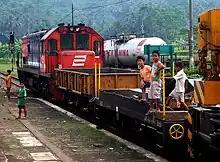
The railway system in Java is more or less a passenger-oriented system, and there are few freight services, due to the limited capacity of the tracks. Some notable freight services in Java include the Kalimas container train and the Parcel train between Jakarta and Surabaya, petroleum trains between refineries or oil pipe terminals and oil depots, and quartz sand trains in Central Java. Besides being operated for Krakatau Steel, the train will later be used to supply steel from Cilegon to other areas.[40]
But in recent years, there have been many efforts to increase freight traffic in Java by introducing the GE CC206 locomotives, as well as building double-track lines that connect Jakarta and Surabaya on the North Coast line to increase the number of container trains between both cities. Many container ports have also been built in intermediate cities and towns. This effort has already attracted some customers who normally shipped their products via road.
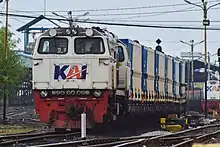
The system in South Sumatra is rather freight-oriented. Coal unit trains, carrying coal for an electricity plant is given priority over passenger trains, and Pulp unit trains to transport pulp for paper mills. In West Sumatra, the remaining railway line serves the cement plant at Indarung, near Padang, and in North Sumatra, several oil palm and rubber plantations are served by freight trains.
In Papua, Freeport Indonesia uses underground trains to carry ore from mine to mill.[41]
Urban rail and rail-based rapid transit

Trams formerly existed in Jakarta, Surabaya, Malang, and Semarang before their service was closed after independence. In Jakarta the tram lines are operated using track gauge 1,188 mm (3 ft 10+25⁄32 in) operated by Bataviasche Verkeers Maatschappij and Pengangkutan Penumpang Djakarta, while in other areas track gauge 1,067 mm (3 ft 6 in) were used.
In Greater Jakarta, KRL Commuterline and Jabodebek LRT is operational urban rail network, serving commuter routes which comprises cities of DKI Jakarta, Depok, Bogor, Bekasi, Tangerang, and South Tangerang as well as regencies of Bogor, Bekasi, and Lebak. The other operational urban rail networks are Jakarta provincially-owned Jakarta MRT, Jakarta LRT, and Soekarno-Hatta Airport Rail Link to support the public transport network in the area.
Regional rail functions as commuter rail in Greater Surabaya, so technically there is no urban rail network. However, there are plans for a mass rapid transit network in and around Surabaya.[42] A 32 km diesel line from Mojokerto to Sidoarjo has been put into service, with 6 daily return trips.
Greater Medan is served by Kualanamu Airport Rail Link. Sri Lelawangsa commuter train connects Medan and nearby Binjai.
In Palembang, Palembang Light Rail Transit had operate in June 2018, before the 2018 Asian Games.[43]
In greater Yogyakarta and Surakarta, KAI Commuter Yogyakarta Line operates between Yogyakarta, Klaten and Surakarta. Prambanan Express connects Yogyakarta with Purworejo. Yogyakarta International and Adisumarmo Airport Rail Links exists in Yogyakarta and Surakarta, respectively.
In Padang, Minangkabau Express is in operation.
Tourist rail
In Indonesia, there are several train lines that were built for tourist destinations, such as the Gamplong tram line in Sleman Regency, Special Region of Yogyakarta using 1,435 mm (4 ft 8+1⁄2 in) track gauge,[44] the Ancol mini train line in Jakarta using 620 mm (2 ft 13⁄32 in) track gauge, and the Taman Mini Indonesia Indah (TMII) tourist mini train line in Jakarta using 670 mm track gauge. In addition to operating mini trains, TMII also operates SHS-23 Aeromovel Indonesia or Titihan Samirono, a light rail which was initially a wind-powered aeromovel.[45]
Industrial railway
Sugar cane
The use of trains as transport from plantations dates back to the 1800s. In the past, to transport sugar cane from plantations to sugar factories, sugar mill companies used narrow gauge trains to transport their sugar cane products. Around the 1970s, the transportation of sugarcane from plantations to factories began using trucks. Since the early 90s, transportation of sugarcane from plantations in Indonesia has been almost entirely using trucks due to lower operational costs, time efficiency, and the reduction in sugarcane land around the sugar factory area.
In addition, due to the increasingly rapid development of transportation, road infrastructure is getting better, and lorries are getting old and slow, over time the use of lorry trains is no longer used, although until now there are still some sugar factories that still operate trains to sugarcane plantations. In addition, some of the train lines are used for tourism, some use steam locomotives and also diesel locomotives. Most of the sugarcane rail lines are operated by PT. Perkebunan Nusantara IX[46]
The use of track gauges in sugar factories in Indonesia varies from place to place, for example:
- Track gauge 600 mm (1 ft 11+5⁄8 in), used in PG Djatiwangi Majalengka, PG Djatibarang Brebes, PG Pangka Tegal, PG Cepiring Kendal, PG Soedhono Ngawi, PG Tulangan Sidoarjo, PG Gendhing Probolinggo, and PG Pandji Situbondo.
- Track gauge 670 mm, only used in PG Kadhipaten Majalengka.
- Track gauge 700 mm (2 ft 3+9⁄16 in), used in PG Gempol Cirebon, PG Tersana Baru Cirebon, PG Ketanggungan Barat Brebes, PG Soemberhardjo Pemalang, PG Rendeng Kudus, PG Kalibagor Banyumas, PG Gondang Winangoen Klaten, PG Kartasoera Surakarta, PG Rejosarie Magetan, PG Poerwodadie Magetan, PG Arasoe Bone Sulawesi, PG Sragie Pekalongan, and others (almost all sugar factories in Java use this track gauge).
- Track gauge 720 mm, only used in PG Sindanglaut Cirebon.
- Track gauge 750 mm (2 ft 5+1⁄2 in), used in PG Bandjaratma Brebes, PG Pakis Baru Pati, PG Trangkil Pati, PG Ceper Baru Klaten, PG Tjolomadoe Solo, and PG Tasikmadu Karanganyar.
Palm oil
In Indonesia there are several palm oil companies that operate trains to transport palm fruit, either from oil palm plantations to mills or just as a means of passing. The oil palm carriage is commonly referred to as "Lori Muntik". The palm oil mills are spread across Sumatra and Kalimantan. The track gauge used is 700 mm (2 ft 3+9⁄16 in). Several large palm oil companies that use this train, including PT. Socfindo, PT. BSP, PTPN II, PTPN IV in Sumatra, and several other palm oil mills.[47]
Rubber plantations
In North Sumatra there is a rubber factory that still operates trains to transport rubber latex to the factory, one of which is PT. Bakrie Sumatra Plantations. The train was pulled by a small diesel locomotive made by Hokuriku, Schöma, and several other small locomotives. The track gauge used is 700 mm (2 ft 3+9⁄16 in).
Mining & oil transport
PT Freeport Indonesia, which is a mining company, operates underground mining trains to facilitate the transportation of copper, gold and silver ore materials to the processing plant location at Mile 74, Tembagapura, Mimika, Papua. The locomotive used is the MMT-M-270-BDE diesel locomotive made by Schalker Eisenhütte Maschinenfabrik, Germany.[48]
Cikotok, Banten formerly known as one of the gold mining areas in Indonesia operated by PT. Antam. In order to smooth the flow of raw gold distribution, a railway line was operated. The train used is a small train with a track gauge of about 700mm. However, because the gold stock here ran out, in 2016 the mine was closed and only ruins were left, as well as the Cirotan mine monument which contained an artificial diesel locomotive Deutz-Fahr on display at that place. Apart from Cikotok, PT Antam also operates mining rail lines in other areas, one of which is in Bogor, West Java[49]
In Sebelimbingan, Pulau Laut, South Borneo there is a relic Dutch coal mine. At that time, a railway line was built from the mine site which was used to transport coal to the port and later brought it to the Netherlands. Now the mines and railroad tracks are just ruins. In addition, in several other areas in South Kalimantan mining railway lines have also been built, such as in Amuntai, Martapura, several other places.[50]
Until around the 1950s, the oil refinery that is now owned by Pertamina in Balikpapan still operated mini trains with small track gauges to transport oil from the refinery to the port. Currently there is no relic left.[51]
High-speed rail
.jpg.webp)
In recent decades, Java's transportation backbones — north coast road and railway system that serves Jakarta-Surabaya corridor, has suffered greatly from both freight and passenger congestion.[52] The plan to build a high-speed railway system in Java has been around for many years. However, it was not until 2008 that the idea had been contemplated seriously. It was Japan International Cooperation Agency's proposal that initiated the idea to build high-speed rail for the Indonesian island of Java, linking up the densely populated corridor from the capital Jakarta to Surabaya city (covering 730 km) in East Java.[53][54] Japan is eager to export their Shinkansen high-speed rail technology abroad. Following up JICA's initial study in 2012, the detailed feasibility study was concluded in 2014. In recent years, Indonesia has been undergoing a revival in railway expansion and upgrades. The high-speed rail corridors have been proposed but not implemented yet, since it was deemed too costly.
In April 2015, China had entered the race with a counter-offer to build the Jakarta-Bandung high-speed rail in Indonesia.[55] A bid which alarmed Japan that has been nurtured the idea for years.
In July 2015, the Indonesian government announced their plan to build the high-speed rail system connecting Jakarta and Bandung, and devised a competition between Japan and China train-makers as potential bidders. Japan and China have expressed their interest in the project; both countries had done comprehensive studies of the project.[56]
In late September 2015, Indonesia awarded this multibillion-dollar railway project to China over Japan.[57][58]
The proposed high-speed rail will connect the nation's capital Jakarta with Bandung city in neighboring West Java province, covering a distance of 150 kilometers, and is also expected to expand further, connecting to Indonesia's second largest city, Surabaya in East Java.[56]
The project has been delayed several times, first due to careless construction that affected nearby roads, then due to coronavirus pandemic restrictions.
In December 2015 discussion for the Jakarta-Surabaya high-speed rail was commenced by the Indonesian Coordinating Minister of Maritime and Resources. Academicians from two major universities in Indonesia, and employees from Japan International Cooperation Agency, were invited to attend the discussion.[59][60]
In May 2020, coordinating Economics Minister Airlangga Hartarto announced that the government had decided to extend the China-backed Jakarta-Bandung high-speed railway project to Surabaya. The line would run along a southern route to connect the Jakarta-Bandung project with Surabaya via Kertajati, where the government recently built a new airport, as well as via Surakarta and Yogyakarta. Meanwhile, Japan is working on the Java North Line Upgrading Project, which would connect Jakarta and Surabaya with a route along the northern coast of Java via Cirebon in West Java and Semarang in Central Java. A proposed travel speed of 150 km per hour for the 720-km railway connection would allow for the use of existing tracks, hence resulting in the lower development cost of about $5 billion.[61]
In 2023, the Jakarta-Bandung High-Speed Rail construction partially finished and is set to start commercial operation starting October 2023.[62] The Jakarta-Bandung HSR began trial operation with passengers on 7 September 2023 and commercial operations on 2 October 2023.[63]
List of all locomotives in Indonesia
This is a list of locomotives in Indonesia that have been/are/will be operated.[64][65]
Steam locomotives
All steam locomotives in Indonesia were operated during the Dutch colonial era to the PJKA era, during the 1980s era. In Greater Jakarta, steam locomotives were operated between 1930s and 1980-1990s (e.g.: steam trams were actually closed in the early 1980s electricity was actually closed at the end of the decade 1990s due to being displaced by electric rail train, diesel locomotive, city transportation and the emergence of ojek motorcycle ). The first locomotives in Indonesia were NIS 1 and 2 belonging to Nederlands-Indische Spoorweg Maatschappij, to serve the Samarang NIS-Tanggung railway line. The following list of steam locomotives in Indonesia does not include all steam locomotives operated by all train operators in the Dutch East Indies. The following is a list of steam locomotives in Indonesia.[66]
Track gauge 1,435 mm (4 ft 8+1⁄2 in)
- Locomotive NIS 107, was built by Hanomag (1907)
Track gauge 1,067 mm (3 ft 6 in)
- Locomotive B1
- Locomotive B10, was built by Beyer, Peacock & Company
- Locomotive B11, was built by Beyer, Peacock & Company (1883–1898)
- Locomotive B12, was built by Werkspoor & Beyer, Peacock & Company (1900–1902)
- Locomotive B13, was built by Hanomag (1879–1886)
- Locomotive B14
- Locomotive B15
- Locomotive B16, was built by Hohenzollern (1896–1900)
- Locomotive B17, was built by Hohenzollern (189–1900)
- Locomotive B18
- Locomotive B19
- Locomotive B20, was built by Beyer, Peacock & Company (1900–1907)
- Locomotive B21
- Locomotive B22, was built by Hartmann (1898–1901)
- Locomotive B23, was built by Henschel
- Locomotive B24
- Locomotive B25, was built by Maschinenfabrik Esslingen (1902)
- Locomotive B26
- Locomotive B27, was built by Hartmann (1912, 1914, & 1921)
- Locomotive B50, was built by Sharp, Stewart & Company
- Locomotive B51, was built by Hartmann, Hanomag & Werkspoor
- Locomotive B52, was built by Hartmann & Chamnitz (1908–1913)
- Locomotive B53, was built by Hartmann Chamnitz & Werkspoor
- Locomotive BB7
- Locomotive BB8, was built by Nippon Sharyo (1962)
- Locomotive BB10, was built by Hartmann, Chamnitz & Scwhartzkopff (1899–1908)
- Locomotive C2
- Locomotive C3
- Locomotive C4
- Locomotive C5
- Locomotive C6
- Locomotive C7
- Locomotive C8
- Locomotive C10
- Locomotive C11, was built by Hartmann (1879–1891)
- Locomotive C12, was built by Saechs Maschinenfabrik vorm. Richard Hartmann & Chemnitz (1893–1902)
- Locomotive C13 was built by John Cockerill & Cie.
- Locomotive C14, was built by Beyer, Peacock & Company (1895–1910)
- Locomotive C15, was built by Hartmann & Werkspoor (1897–1900)
- Locomotive C16, was built by Hartmann (1899–1908)
- Locomotive C17, was built by Hartmann (1899–1902)
- Locomotive C18, was built by Hartmann (1908)
- Locomotive C19, was built by Hartmann (1898–1902)
- Locomotive C20, was built by Hartmann (1903 & 1912)
- Locomotive C21, was built by Krauss (1903–1926)
- Locomotive C22, was built by John Cockeril & Cie.
- Locomotive C23, was built by Hartmann
- Locomotive C24, build by Werkspoor
- Locomotive C25, was built by Hanomag
- Locomotive C26, was built by Henschel (1914–1926)
- Locomotive C27, was built by Schweizerische Lokomotiv-und Maschinefabrik, Armstrong-Whitworth & Werkspoor (1916–1922)
- Locomotive C28, was built by Hanomag, Henschel Kasseel, & Esslingen (1921)
- Locomotive C29, build by Hanomag (1922)
- Locomotive C30, build by Hohenzollern, Borsig, Hanomag & Werkspoor (1929–1930)
- Locomotive C31, build by Hohenzollern, Borsig, Hanomag, & Werkspoor
- Locomotive C32, build by Nippon Sharyo
- Locomotive C33, build by Esslingen (1891–1904)
- Locomotive C50, was built by Hartmann & SLM (1914-1918)
- Locomotive C51, was built by Beyer, Peacock & Company
- Locomotive C52, was built by Werkspoor, Henschel Kassel Beyer, Peacock & Company (1918–1922)
- Locomotive C53, was built by Werkspoor N.V (1918–1922)
- Locomotive C54, was built by Hartmann & Beyer, Peacock & Company
- Locomotive CC10, was built by Hartmann & Werkspoor (1904-1911)
- Locomotive CC50, was built by Werkspoor and SLM (1927–1928)
- Locomotive D1
- Locomotive D10, was built by Hartmann
- Locomotive D11, was built by Hohenzollern
- Locomotive D13, was built by Hohenzollern
- Locomotive D14, was built by Hanomag & Werkspoor (1912–1922)
- Locomotive D15, was built by Hanomag
- Locomotive D16
- Locomotive D17
- Locomotive D18
- Locomotive D50, was built by Schweizerische Lokomotiv und Maschinefabrik Winterthur, Hanomag, Hartmann & Werkspoor (1914, 1915, & 1921)
- Locomotive D51, was built by Sächsische Maschinenfabrik (Hartmann)
- Locomotive D52, was built by Fried Krupp (1951–1955)
- Locomotive DD50, was built by American Locomotive Company (1916)
- Locomotive DD51, was built by American Locomotive Company (1919)
- Locomotive DD52, was built by Werkspoor, Hanomag and Hartmann (1923–1924)
- Locomotive E10, was built by Maschinenfabrik Esslingen, Swiss Locomotive & Machine Works, & Nippon Sharyo (1922–1928, 1964)
- Locomotive F10, was built by Hanomag & Werkspoor (1896)
- Locomotive DSM 22, was built by Hohenzolllern
- Locomotive DSM 28, was built by Hohenzollern
- Locomotive DSM 38, was built by Hartmann
- Locomotive DSM 48, was built by Werkspoor
- Locomotive DSM 55, was built by Werkspoor
Track gauge 762 mm (2 ft 6 in)
- Pakis Baru No. 1, build by Orenstein & Koppel
- Pakis Baru No. 5, build by Orenstein & Koppel
Track gauge 750 mm (2 ft 5+1⁄2 in)
- Banjaratma No. 10
- Ceper Baru No. 5
- Colomadu No. 1
- Pakis Baru No. 2
- Tasikmadu No. 3 1908, build by Borsig
- Tasikmadu No. 5
- Tasikmadu TM 1, build by Orenstein & Koppel
- Tasikmadu TM 5
- Tasikmadu TM IV
- Tasikmadu TM VI, build by Orenstein & Koppel
- Tasikmadu TM IX (Lokomotiv Doon)
- Tasikmadu TM X
- Tasikmadu TM XIV
- Trangkil No. 4, build by Hunslet
Track gauge 720mm
- Sindanglaut No. 4
- Sindanglaut No. 7
- Sindanglaut No. 8
- Sindanglaut No. 10
- Sindanglaut No. 11
- Sindanglaut No. 13
Track gauge 700 mm (2 ft 3+9⁄16 in)
- Bromo No. 5 (owned by PG Olean)
- Gempol No.2
- Gondang Winangun No. 14
- Kalibagor No. 20
- Kartasura No.5
- Kedawung No. 14
- Ketanggungan No. 11
- Olean No. 1
- Olean No. 7
- Pagottan No. 7
- Purwodadi No. 1
- Purwodadi No. 10
- Rejosari No. 10
- Rendeng No. 6
- Semboro No. 14
- Semboro No. 15
- Semboro No. 29, build by Jungenthal
- Semeru No. 4 (owned by PG Olean)
- Sragi No. 16
- Sumberharjo No. 3
- Sumberharjo No. 4, build by Ducroo & Brauns Locmotieffabriek
- Sumberharjo No. 10, build by American Locomotive Company
- Sumberharjo No. 15
- Tersana No. 2
- Tersana No. 6
- Wringinanom No. 06
Track gauge 660mm
- Kadhipaten No. 2
- Locomotive TD10, build by Werkspoor
Track gauge 610 mm (2 ft)
- Jatibarang 9, build by Arnold Jung Lokomotivfabrik
- Sragi No.1, build by Krauss
- Sragi No. 14 Max, build by Orenstein & Koppel
Track gauge 600 mm (1 ft 11+5⁄8 in)
- Cepiring No. 6
- Gendhing No. 8
- Jatibarang No. 9
- Jatibarang No 10
- Jatiwangi No. 5
- Locomotive SS 200T/300T
- Locomotive TC10, build by Hartmann
- Pangka No. 1, build by Jungenthal
- Pangka No. 3, build by ARN JUNG GmbH
- Pangka No. 10, build by Orenstein & Koppel
- Panji No. 15
- Suedhono No. 10
- Tulangan No. 5
Fireless steam locomotive
Track gauge 700 mm (2 ft 3+9⁄16 in)
- Pagottan No. 7, build by Orenstein & Koppel
- Pagottan No. 8, build by Orenstein & Koppel
- Semboro No. 2
- Semboro No. 03
Diesel locomotives
A diesel locomotive is a rail vehicle that uses the power of diesel to propel a whole series of trains.[66]
Electric diesel
Track gauge 1,435 mm (4 ft 8+1⁄2 in)
- DF4B, build by Sifang, Datong, Ziyang, & Dalian & Siemens (owned by Kereta Cepat Indonesia–China for the construction of the Jakarta-Bandung high-speed train)[67][68][69]
- GK0C, build by CRRC Yangtze (owned by Krakatau Steel)[70]
Track gauge 1,067 mm (3 ft 6 in)
- A200 (namely Gajah Mada)[71]
- BB200, build by General Motors-Motive Division (1957)
- BB201, build by General Motors-Motive Division (1964)
- BB202, build by General Motors-Motive Division (1968–1971)
- BB203, build by GE Transportation (1978–1985)
- BB204, build by SLM (1982–1983)
- CC200, build by ALCO-General Electric (1953)
- CC201, build by General Electric Transportation (1976–1992)
- CC202, build by Progress Rail (1986–2008)
- CC203, build by GE Transportation & UGL Rail (1995–2000)
- CC204, build by PT INKA, under licensed by GE Transportation (2003–2011)
- CC205, build by Progress Rail (2011–now)
- CC206, build by General Electric (2012–2016)
Hydraulic diesel
Track gauge 1,067 mm (3 ft 6 in)
- BB300, build by Fried Krupp (1958–1959)
- BB301, build by Fried Krupp-Krauss-Maffei (1964–1970)
- BB302, build by Henschel
- BB303, build by Henschel (1973–1984)
- BB304, build by Fried Krupp (1976–1984)
- BB305, build by Nippon Sharyo, Jenbacher Werke & CFD
- BB306, build by Henschel (1984)
- 300, build by VEB Lokomotivbau Karl Marx Babelsberg
- C301, build by NCM Holland
- CC300, build by PT INKA (owned by Ditjen Perkeretaapian)
- 300, build by Fried Krupp (1958)
- 301, build by Fried Krupp (1962–1963)
- DD5512, build by Fuji Heavy Industry (owned by Ditjen Perkeretaapian)[72][73]
Track gauge 750 mm (2 ft 5+1⁄2 in)
- C301, build by NCM Holland
Mechanic diesel
Track gauge 1,067 mm (3 ft 6 in)
- B100, build by Balai Yasa Pengok Yogyakarta (1960)
- B200, build by Balai Yasa Yogyakarta (1961)
- B201, build by Balai Yasa Yogyakarta (1962)
- Bima Kunthing, build by BY Yogyakarta
- Kebo Kuning, build by Schoema
- Pelita 1, build by Balai Yasa Yogyakarta
Plantations diesel locomotive
Track gauge 750 mm (2 ft 5+1⁄2 in)
- Tasikmadu No. 21
- Tasikmadu No. 25
Track gauge 720mm
- Sindanglaut No. 19
Track gauge 700 mm (2 ft 3+9⁄16 in)
- Kedawung No. 9, build by Schöma
- Madu Kismo No. 10
- PT. Antam Cikotok, build by Deutz-Fahr
- PT. Bakrie Sumatra Plantations (unknown fleet number), build by Hokuriku & Schöma
- PT. BSP (unknown number fleet), build by Hokuriku & Schöma
- PT. Socfindo (unknown number fleet), build by Hokuriku & Schöma
- PTPN II (unknown fleet number), build by Hokuriku & Schöma
- PTPN IV (unknown fleet number), build by Hokuriku & Schöma
Track gauge 670mm
- Kadipaten No. 19
Track gauge 600 mm (1 ft 11+5⁄8 in)
- Pangkah No. 13
- Pangkah No. 15
Electrical locomotives
Track gauge 1,067 mm (3 ft 6 in)
- ESS 3000, build by Swiss Locomotive & Machine Works, Brown, Boveri & Cie (1924-1927)
- ESS 3100
- ESS 3200, build by Werkspoor N.V
- ESS 3300
- ESS 4000
Hybrid locomotive
Track gauge 1,067 mm (3 ft 6 in)
- MMT-M-270-BDE, build by Schalker Eisenhutte Maschinenfabrik (owned by Freeport Indonesia for underground mining operations)[74]
Laws and regulations
Before creating their own laws and regulations, Indonesian rail transport laws and regulations were inherited from Dutch East Indies laws, including:[75]
- Algemeene Regelen betreffende den Aanleg en de Exploitatie van Spoor en Tramwegen, bestemd voor Algemeen Verkeer in Nederlandsch-Indië (Dutch East Indies Construction and Operation of Railways and Tramways for General Traffic Act)
- Algemeene Bepalingen betreffendede Spoor en Tramwegen (Railways and Tramways Act)
- Bepalingen betreffende den Aanleg en het Bedrijf der Spoorwegen (Regulation on Construction and Operation of Railways)
- Bepalingen voor de stadstramwegen (Regulation on Urban Tramways)
- Bepalingen Landelijke Tramwegen (Regulation on Rural Tramways)
- Bepalingen betreffende het Vervoer over Spoorwegen (Regulation on Transport by Rail)
- Industriebaan Ordonnantie (Industrial Railways Ordinance)
On 1992, President Suharto passed the 1992 Indonesian Railways Act No. 13, replacing all the regulations above. On the end of March 2007, the People's Representative Council had passed the current law replacing 1992 act, the 2007 Indonesian Railways Act. In the current law, private and regional investors have a chance to manage rail transport, so the domination and monopoly of the KAI were abolished.[76]
See also
- Polsuska
- Transport in Indonesia
- List of named passenger trains of Indonesia
- List of railway stations in Indonesia
- List of railway companies in the Dutch East Indies
- List of defunct railway in Indonesia
- List of all locomotives in Indonesia
References
- "Indonesia's Railway Renaissance - The Diplomat". The Diplomat. 19 January 2022. Retrieved 26 January 2022.
- "Jumlah Barang Melalui Transportasi Kereta Api Menurut Pulau, 2006-2015 (Ribuan Ton)". Badan Pusat Statistik. Archived from the original on 14 March 2015. Retrieved 13 January 2022.
- Mohammad, Yandi (30 September 2015). "Jalur kereta yang kian menyusut". beritagar.id. Archived from the original on 3 October 2015. Retrieved 3 October 2015.
- Teguh, Irfan (6 January 2019). "Kisah Terowongan Sasaksaat dan Lampegan". Tirto.id (in Indonesian). Retrieved 11 August 2020.
- Kautsar, Nurul Diva (31 May 2020). "Jadi Jembatan Kereta Api Terpanjang di Indonesia, Ini 4 Fakta Cikubang yang Melegenda". Merdeka.com (in Indonesian). Retrieved 11 August 2020.
- "Stasiun Pasar Turi Surabaya Terendah di Indonesia, Kok Bisa?". Liputan6.com (in Indonesian). 30 January 2020. Retrieved 11 August 2020.
- Osman, Nurfika (14 November 2012). "Central Kalimantan's $2.8b coal railway to kick off early next year". Jakarta Post.
- Hajramurni, Andi (25 November 2015). "Jokowi promises more funding for Trans-Sulawesi rail project". The Jakarta Post. Retrieved 28 December 2015.
- Chan, Francis; Soeriaatmadja, Wahyudi (4 September 2017). "Indonesia's national rail network aims for more growth, less inequality". The Straits Times. Retrieved 8 September 2017.
- "Indonesia looking to extend railway network by 2030". New Straits Times. Retrieved 10 November 2022.
- Sujadi 2016, p. 114.
- Rastika 2011.
- Black, John (2016). "3. National Railway System". In Loo, Becky P. Y.; Comtois, Claude (eds.). Sustainable Railway Futures. Routledge. p. 42. ISBN 9781409452430.
- Jatmiko, Bambang Priyo, ed. (10 December 2013). "Pemerintah Bangun Jalur KA Trans Sumatra Mulai 2014". KOMPAS.com.
- "The slow train | the Jakarta Globe". Archived from the original on 14 November 2011. Retrieved 20 March 2012.
- "Railways in Kalimantan". sinfin.net. Retrieved 11 July 2021.
- Railway Gazette International November 2010, p56
- "RZD to finish building Kalimantan railway in 2019". 12 January 2016. Retrieved 5 June 2019.
- Bahfein, Suhaiela (4 March 2022). Alexander, Hilda (ed.). "Investor Rusia Mundur, Kereta Api Borneo Batal". kompas.com (in Indonesian). Retrieved 19 April 2022.
- "All aboard! Is an electric rail network in Bali feasible?". Gapura Bali. 22 May 2019. Retrieved 5 June 2019.
- "Gevonden in Delpher - Het nieuws van den dag voor Nederlandsch-Indië". Het Nieuws van den Dag voor Nederlandsch-Indië (in Dutch). 14 August 1930. Retrieved 11 July 2021.
- Nasrul, Fadli; Najamuddin, Najamuddin; Asmunandar, Asmunandar (28 February 2019). "Transportasi Kereta Api Rute Makassar- Takalar (1922- 1930)". Pattingalloang. 5 (3): 1–11. doi:10.26858/pattingalloang.v5i3.8514 (inactive 1 August 2023). ISSN 2686-6463. Archived from the original on 15 March 2022. Retrieved 11 July 2021.
{{cite journal}}: CS1 maint: DOI inactive as of August 2023 (link) - "Proyek Kereta Api Sulawesi Lebih Cepat dari Jawa". Tribun Jateng (in Indonesian). 24 October 2016. Retrieved 11 April 2018.
- Bintang, Amri (30 November 2017). "Buatan PT INKA! Inilah Kereta Inspeksi Trans Sulawesi Milik Kemenhub". KAORI Nusantara (in Indonesian). Retrieved 11 April 2018.
- Ginting, Xenos Zulyunico. "Besok Kereta Api Sulsel Mulai Beroperasi Terbatas, Lewati Rel 66 Km-7 Stasiun". detiksulsel (in Indonesian). Retrieved 8 November 2022.
- Simangunsong, Wasti Samaria (30 October 2022). Tashandra, Nabilla (ed.). "Gratis, Kereta Api di Sulawesi Selatan Selama Uji Coba Halaman all". KOMPAS.com (in Indonesian). Retrieved 8 November 2022.
- "Papua railway, on the priority list of projects". Railway Pro. 17 February 2016. Retrieved 13 July 2019.
- Zafna, Grandyos. "Menilik Kereta Otomatis di Tambang Grasberg Freeport". Detik.
- "Institut Pertambangan Nemangkawi".
- "Trangkil No.4". Statfold Barn Railway. Archived from the original on 18 March 2015. Retrieved 30 September 2015.
- Ika, Aprillia, ed. (28 June 2016). "KAI dan GE Teken Kerja Sama Pemeliharaan Lokomotif Selama Delapan Tahun". KOMPAS.com.
- "5 Sejarah lokomotif KA terbaik di Indonesia, sudah... - GE Reports Indonesia". Archived from the original on 10 December 2017. Retrieved 17 December 2017.
- "KAI Commuter". commuterline.id. Retrieved 19 March 2023.
- Pitoko, Ridwan Aji (11 June 2018). Djumena, Erlangga (ed.). "Kereta "Sleeper" Beroperasi Besok, Harga Tiket Promo Rp 900.000". KOMPAS.com.
- "Indonesia Railway Company Launches Women-Only Carriages". The Jakarta Globe. Archived from the original on 21 August 2010. Retrieved 19 March 2023.
- Laeis, Zuhdiar (15 May 2013). Saputra, Desy (ed.). "Dahlan: yang dihapus kereta khusus wanita, bukan gerbong". Antara.
- Adiakurnia, Muhammad Irzal (11 June 2018). Nursastri, Sri Anindiati (ed.). "Luxury Sleeper Train Mulai Beroperasi, Ini Harga Promonya". KOMPAS.com (in Indonesian). Retrieved 20 March 2019.
- "Kereta First Class Hadir di RI, Harga Tiket Rp 900.000". CNBC. Retrieved 20 March 2019.
- "KAI121 on Instagram: "Bisa senyaman inikah kamu menikmati perjalanan #Mudik2018? Bisa dong! Dapatkan tiket KA #ArgoBromoAnggrekLuxury #SleeperTrain rute Gambir-…"". Instagram. Archived from the original on 24 December 2021. Retrieved 20 March 2019.
- Sulistyo, Bayu Tri (30 December 2017). "Lokomotif Langsir Krakatau Steel Tiba di Cilegon". Railway Enthusiast Digest.
- "PTFI's Grasberg Block Cave. Successfully Wet Commissioned". Freeport Indonesia. 24 August 2018. Retrieved 11 July 2022.
- Harsaputra, Indra (22 January 2011). "Railway line to connect airport with downtown Surabaya". The Jakarta Post.
- Siregar, Raja Adil (20 May 2017). "Menhub Tinjau LRT Palembang, Pastikan Rampung Sebelum Asian Games". detikfinance. Retrieved 22 May 2017.
- Rizky, Suryo (2021). "Desa Wisata Gamplong Mini Hollywood Tempat Syuting Bumi Manusia". Pariwisata Indonesia. Retrieved 15 August 2022.
- "Taman Mini "Indonesia Indah"". Archived from the original on 10 August 2020. Retrieved 17 August 2023.
{{cite web}}: CS1 maint: bot: original URL status unknown (link) - Semboyan35 Indonesian Railfans - Mblusuk Jalur Lori jaman Belanda
- "Penyesalan Selalu Datang Terlambat, Jejak Lori di Sawit Seberang". 10 October 2016.
- MMT-M-270-BDE Lokomotif Yang Beroperasi di Freeport Papua, 17 November 2015
- "Buletin Purnantam" (PDF). Buletin Purnantam (in Indonesian). January–June 2020. Archived (PDF) from the original on 11 May 2023. Retrieved 14 August 2023.
- Ini Bukti Kalau Sebelimbingan Kota yang Hilang, Masih Ditemukan Rel Kereta Api
- Balikpapan Tempo Doeloe – Kereta Api di kilang Pertamina 1950, 9 December 2009
- Zakir Hussain, The Straits Times/ANN (28 October 2013). "Jakarta mulls high-speed rail system". The Jakarta Post. Jakarta.
- "Java High Speed Railway Development Project (Phase I)". Japan International Cooperation Agency. 2010. Retrieved 1 October 2015.
- Harding, Robin; Chilkoti, Avantika; Mitchell, Tom (1 October 2015). "Japan cries foul after Indonesia awards rail contract to China". Financial Times. Archived from the original on 11 December 2022. Retrieved 1 October 2015.
- "Japan loses Indonesian high-speed railway contract to China". The Japan Times. 30 September 2015. Retrieved 1 October 2015.
- Sihite, Ezra; Purnamasari, Deti Mega (14 July 2015). "Indonesia Plans 'Beauty Contest' Between China and Japan for High-Speed Train". Jakarta Globe. Retrieved 1 October 2015.
- Kapoor, Kanupriya (29 September 2015). Fernandez, Clarence (ed.). "Indonesia to award fast train contract to China - Japanese embassy official". Reuters. Retrieved 1 October 2015.
- "Indonesia awards multi-billion-dollar railway project to China over Japan". ABC. 30 September 2015. Retrieved 1 October 2015.
- Chandra, Ardan Adhi (12 September 2017). "Mengintip Kajian Rute Kereta Kencang Jakarta-Surabaya". Finance.detik.com. Retrieved 20 March 2019.
- S, Ari (20 October 2016). "Dengan Kereta Kencang, Jakarta-Surabaya Cuma 4 Jam". Archived from the original on 11 July 2018.
- "China or Japan: Indonesia mulls Jakarta-Surabaya railway plans". The Star (Malaysia). 21 September 2021.
- "Indonesia set to open Southeast Asia's 1st high-speed rail in October". Nikkei Asia. Retrieved 9 September 2023.
- https://www.thejakartapost.com/business/2023/08/08/high-speed-railway-delayed-again-but-its-for-the-better-experts-say.html
- "Inilah Deretan Lokomotif Uap yang Aktif Bersama KAI". redigest.web.id (in Indonesian). 30 August 2021. Retrieved 10 November 2021.
- Prayogo, Yoga Bagus; Prabowo, Yohanes Sapto; Radityo, Diaz (2017). Kereta Api di Indonesia: Sejarah Lokomotif Uap (in Indonesian). Yogyakarta: Jogja Bangkit Publisher. pp. 47–49, 54–55, 60–61, 96, 103–107. ISBN 978-602-0818-55-9.
- (in Indonesian) Indonesian Heritage Railway: Sarana Archived 2014-05-13 at the Wayback Machine
- "Lokomotif China Railway DF4B Dikirim ke Bandung". 21 January 2022. Retrieved 19 February 2022.
- "Dua Lagi Lokomotif China Railway DF4B Dikirim ke Bandung". Retrieved 19 February 2022.
- "Lokomotif DF4B Kembali Tiba di Jakarta, Kali Ini Tidak Sendirian". 28 January 2022. Retrieved 19 February 2022.
- Pascal, Muhammad (3 April 2021). "Lokomotif Langsir Krakatau Steel Tiba di Cilegon - Railway Enthusiast Digest". Redigest.web.id. Retrieved 13 August 2022.
- "Indonesian Railways". Retrieved 13 September 2018.
- "DD5512: Lokomotif Jepang yang Penuh Misteri". 12 May 2016. Retrieved 19 February 2022.
- "Salinan arsip". Archived from the original on 1 April 2019. Retrieved 26 February 2019.
- "References - Schalke Locomotives". Schalke.eu. 27 November 2020. Archived from the original on 29 March 2022. Retrieved 13 August 2022.
- Beyen, K.H. (1929). De spoor- en tramwegwetgeving in Nederlandsch-Indië. Den Dienst der Staatsspoor-en Tramwegen and de Vereniging van Nederlandsch-Indische Spoor- en Tramwegmaatschappijen. pp. 16–17.
- Media, Kompas Cyber (26 July 2011). "Swasta dan Pemda Bisa Investasi ke KRL". KOMPAS.com (in Indonesian). Retrieved 9 May 2023.
Sources
- United States Central Intelligence Agency (June 2, 2005), The World Fact Book: Indonesia. Retrieved June 17, 2005.
- Garratt, Colin. The World Encyclopedia of Locomotives Anness Publishing (London), 2003, p. 47.
- History of Railways in Indonesia
- Rastika, Icha (14 November 2011). "Mantan Dirjen KA Dituntut Lima Tahun Penjara". Kompas.com (in Indonesian). Retrieved 19 February 2021.
- Sujadi, Akhmad (2016). Si Ular Besi Antar Jonan Jadi Menteri (in Indonesian). Jakarta: Gramedia Pustaka Utama. ISBN 9786020324661.
Further reading
- How the Railroad is Modernising Asia, The Advertiser, Adelaide, S. Australia, 22 March 1913. N.B.: The article is of approx. 1,500 words, covering approx. a dozen Asian countries.
External links
- Regulator
- Operators
